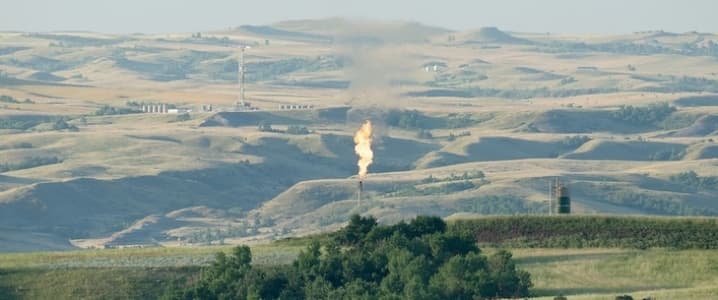If shale plays were people, everyone would be jealous of the Permian for getting all the attention. It is the leader in overall national oil output growth, and just last year the USGS announced a new estimate for part of it, the Wolfcamp Basin, which is now thought to contain as much as 20 billion barrels of recoverable oil.
It’s perhaps this new assessment that has prompted North Dakota government officials to request a new estimate for the Bakken-Three Forks formation. The last one, from 2013, estimated the recoverable reserves of crude in the formation at 7.4 billion barrels – twice the amount of reserves estimated by the USGS five years earlier. Now, one North Dakota senator says, these must be higher thanks to the constant improvement in extraction technology, Inside Energy’s Amy Sisk writes.
Senator John Hoeven says that a new estimate would motivate oil and gas companies to continue investing in North Dakota and prompt more of them to come to the Bakken and Three Forks. That’s especially true now that even Big Oil is turning to shale, where turnaround times and returns are both faster than in large-scale projects.
North Dakota produced 1.03 million barrels of oil daily as of June, the most recent month for which there is data from the state’s Mineral Resources Department. There are 54 active drilling rigs in the state as of August 30, up from 33 a year ago but down from 76 two years ago. Despite the increase in rig count, production growth has been slow because of a shortage of fracking crews—something that’s becoming increasingly common across the shale patch as the industry recovers and demand for oilfield services outstrips supply.
Related: Kurdish Independence Could Deal A Major Blow To Oil Markets
Sen. Hoeven believes now is the time to act to attract the investments of big players such as Exxon. These, he says, are global companies that need to pick the places to invest in. “We want their investments here,” he says, as quoted by Sisk. To get new investments, the state must be able to offer oil and gas producers sustainable production. “We have to continue to make the case this play is going to continue to be here a long time, 10, 20, 30, 50 years,” Hoeven says.
Yet there are no guarantees. A new estimate could actually lower the recoverable reserves of the Bakken-Three Forks formation. USGS estimates rely in part on data that is collected from oil and gas operators in the play under review. The data includes new well numbers and their output rates. Given that the last two years saw a marked decline in production across the board, the chances of the new USGS coming up negative for North Dakota are real.
Related: Oil Prices Rise As Texas Braces For Hurricane Harvey Landfall
On the other hand, technology has been moving quickly during these same two years, and E&Ps have become capable of getting more oil out of the ground. This could tip the scales in the direction that Sen. Hoeven and his colleagues want. According to the USGS, what will determine the need for a new assessment is the extent to which oil production in North Dakota has changed since 2013.
One other thing besides reserves should make North Dakota more appealing for oil and gas players: the notorious Dakota Access pipeline started operations in June, replacing the costlier railways, which carried as much as a quarter of the Bakken output to refineries. Now, three-quarters of North Dakota oil is carried by pipelines. With its extensive infrastructure in place, what the state needs may indeed be a little push from the USGS with new data about its recoverable reserves. As long as the data is positive.
ADVERTISEMENT
By Irina Slav for Oilprice.com
More Top Reads From Oilprice.com:
- Hurricane Harvey Causes Gasoline Price Spike
- Two Countries Could Push Oil Over $50
- Forget OPEC, China Controls Oil Prices



















So what changed with the start of the pipeline? Before the pipeline, railways carried a "quarter of the Bakken output". Now three-quarters is carried by pipelines, with presumably a quarter carried by rail. Must be a "typo" somewhere.